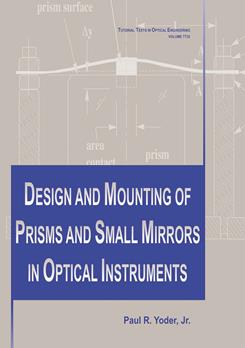|
This tutorial text is intended to provide practitioners in the fields of optical engineering and optomechanical design with a comprehensive understanding of several different ways in which prisms and small mirrors typically are designed and mounted in optical instruments, the advantages and disadvantages of these various mounting arrangements, and some analytical tools that can be used to evaluate and compare different designs. The presentation does not include the theoretical background for these tools, but does cite the sources for the equations listed. Each section contains an illustrated discussion of the technology involved and, wherever feasible, one or more worked-out practical examples.
The text is based, in part, on short courses on Precision Optical Component Mounting Techniques offers by SPIE - The International Society for Optical Engineering, that I have had the privilege of teaching over a period of years. Techniques for mounting lenses which also are covered in those courses are discussed in another tutorial text Mounting Lenses in Optical Instruments published as TT21 in 1995 by the SPIE Press. Because of page limitations, the mirrors considered here have major dimensions no larger than about 24 in. (61cm). Much of the material included here is applicable to any sized mirrors, but the treatment of those topics in the context of larger sized optics is not comprehensive. In depth tutorial treatment of the design and mounting of larger mirrors would make a useful future contribution by some ambitious author.
The designs discussed here are drawn from the literature, my own experiences in optical instrument design and development, and the works of colleagues. I acknowledge the contributions of others with my deepest thanks and sincerely hope that I have accurately recorded and explained the information given to me. I further acknowledge and thank Robert Ginsberg, Alson Hatheway, and Donald O'Shea who reviewed this book in its preliminary form and offered many valuable suggestions for improvements.
The mounting stress theories discussed in Chapters 5 and 8 have not previously been covered explicitly to this depth in the literature and can only be considered as approximations. These theories would benefit from further investigation and refinement based on more precise computational methods such as finite element analysis. Comments, corrections, and suggestions for improvements in the presentations of these topics or in any other portion of this book would be welcomed.
I wish for the readers of this book a deepening understanding of the technologies discussed and success in the application of the concepts, designs, and analytical techniques presented here.
Paul R. Yoder, Jr.
Norwalk, Connecticut
June 1998
|



